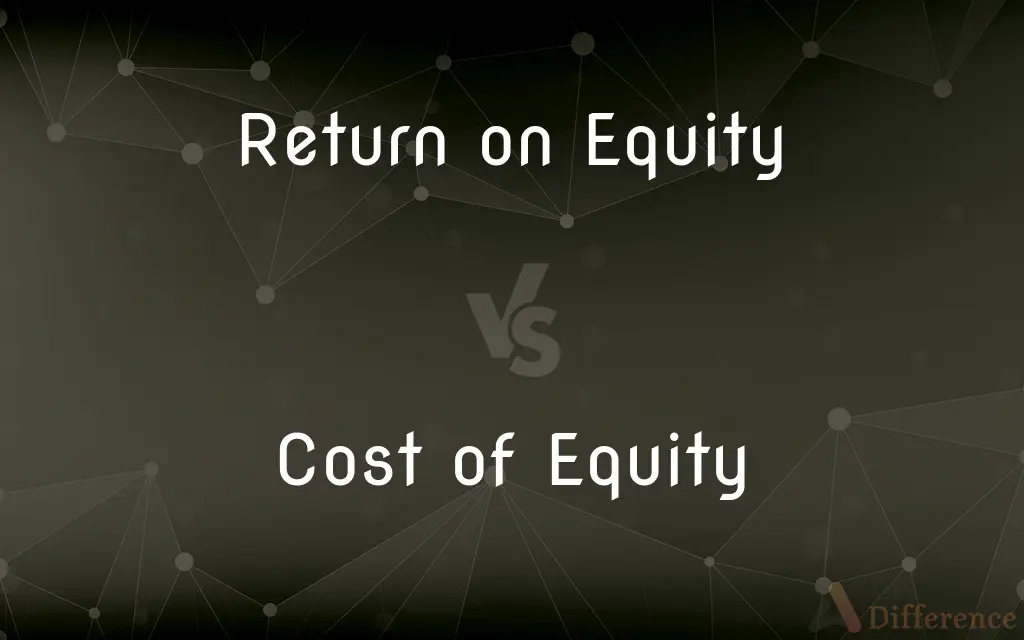Return on Equity vs. Cost of Equity — What's the Difference?
By Tayyaba Rehman — Published on November 20, 2023
"Return on Equity (ROE)" measures profitability by showing how much profit a company generates from shareholders' equity. "Cost of Equity" represents the return required by equity investors for their investment in a firm.

Difference Between Return on Equity and Cost of Equity
Table of Contents
ADVERTISEMENT
Key Differences
"Return on Equity (ROE)" is a financial metric that calculates the amount of net income returned as a percentage of shareholders' equity. Essentially, it indicates how well a company utilizes shareholders' funds to generate earnings. "Cost of Equity," on the other hand, is the compensation demanded by investors for investing in a particular stock, representing the risk taken by them.
When a company achieves a high "Return on Equity," it denotes that the firm is efficient in generating profits from its equity capital. "Cost of Equity" signifies the expectation set by shareholders for a specific return on their investments, based on the perceived risk of the stock.
One key difference is in their implications. While "Return on Equity" is a measure of performance, indicating a company's ability to generate profits, "Cost of Equity" is more about expectations, signifying the return that investors anticipate for bearing the risk of investing in a company.
In financial analysis, "Return on Equity" serves as a tool to assess a company's profitability. Companies with consistent and increasing ROE over time are often viewed favorably. Conversely, "Cost of Equity" is essential in capital budgeting and determining a company's capital structure. It helps in valuing projects and ensuring that they meet investors' return expectations.
While "Return on Equity" is an outcome, reflecting past or present performance, "Cost of Equity" is forward-looking, concerned with future returns expected by investors. Understanding both metrics is crucial for investors, as they provide insight into a company's efficiency and potential returns, respectively.
ADVERTISEMENT
Comparison Chart
Definition
Measures profitability in terms of shareholders' equity.
Represents the return required by equity investors.
Perspective
Looks at past or present performance.
Forward-looking, based on future expectations.
Importance
Indicates a firm's efficiency in generating profits.
Sets expectations for a firm's return on investment.
Calculation Base
Derived from financial statements (net income and equity).
Based on the risk and expected market return.
Use in Financial Analysis
Evaluates profitability and efficiency.
Used in capital budgeting and valuation.
Compare with Definitions
Return on Equity
Reflects the return earned on equity investments.
Investors often compare the ROEs of different companies to gauge profitability.
Cost of Equity
Determines the minimum return necessary to satisfy equity investors.
If Company G doesn't exceed its cost of equity, it may not attract investors.
Return on Equity
Assesses a company's ability to produce earnings from shareholders' investments.
High ROE values indicate Company C is adept at converting equity investments into profits.
Cost of Equity
The return shareholders expect for their risk in a stock.
High-risk stocks generally have a higher cost of equity.
Return on Equity
Indicator of financial performance based on shareholders' equity.
Analysts often use ROE to assess the financial health of Company D.
Cost of Equity
A crucial component in calculating a company's Weighted Average Cost of Capital (WACC).
Company F's WACC depends significantly on its cost of equity.
Return on Equity
A profitability ratio depicting net income as a percentage of shareholders' equity.
If Company A has an ROE of 15%, it means it generated a 15% profit on shareholders' equity.
Cost of Equity
Helps in assessing the viability of projects from an equity investor's perspective.
Company H might reject a project if its return is below the cost of equity.
Return on Equity
Measures how effectively equity capital generates profits.
A rising ROE suggests Company B is enhancing its ability to generate profits from its equity.
Cost of Equity
Represents the compensation required by equity investors.
If Company E's cost of equity is 8%, investors expect an 8% return for their investment risk.
Common Curiosities
Why is "Cost of Equity" essential for companies?
It helps companies understand the return they need to provide to satisfy their equity investors.
Can a company have a "Return on Equity" higher than its "Cost of Equity"?
Yes, and it often indicates the company is providing a satisfactory return to its shareholders.
What does "Return on Equity" measure?
It measures how much profit a company generates from its shareholders' equity.
How is "Cost of Equity" determined?
It's based on the risk-free rate, beta (stock volatility), and the expected market return.
Why might two similar companies have different "Return on Equity" values?
Differences in management efficiency, financial leverage, or industry conditions can result in varied ROEs.
Is "Cost of Equity" always higher than the cost of debt?
Generally, yes, because equity investors bear more risk than debt holders.
Which is more forward-looking, "Return on Equity" or "Cost of Equity"?
"Cost of Equity" is more forward-looking as it's based on future expectations.
Is a higher "Return on Equity" always better?
Generally, a higher ROE indicates better financial performance, but it's essential to compare it with industry peers.
Is "Cost of Equity" the only cost companies consider when raising capital?
No, firms also consider the cost of debt and other capital sources.
Is "Cost of Equity" constant for a company?
No, it can change based on market conditions and company-specific factors.
Does a higher "Cost of Equity" indicate higher risk?
Yes, a higher cost of equity typically signifies greater perceived risk by investors.
How does debt impact "Return on Equity"?
Leverage can amplify ROE, but higher debt also means more risk.
Should companies always aim for a higher "Return on Equity"?
Not necessarily. Companies should weigh ROE against the associated risks.
Can "Return on Equity" be negative?
Yes, if a company reports a net loss, its ROE will be negative.
Share Your Discovery

Previous Comparison
Grams vs. Kilograms
Next Comparison
Cheque vs. Bill of ExchangeAuthor Spotlight
Written by
Tayyaba RehmanTayyaba Rehman is a distinguished writer, currently serving as a primary contributor to askdifference.com. As a researcher in semantics and etymology, Tayyaba's passion for the complexity of languages and their distinctions has found a perfect home on the platform. Tayyaba delves into the intricacies of language, distinguishing between commonly confused words and phrases, thereby providing clarity for readers worldwide.












































